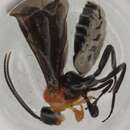en
names in breadcrumbs


Physotarsus is not demonstrably monophyletic. A large number of undescribed species available only as singletons renders the task of delimiting the genus more difficult. At present, Physotarsus is best recognized by the absence of the clypeal features that define the other genera of Scolobatini s. s.
Type species: Tryphon maculipennis Cresson, 1874, by original designation.
Townes 1966: 139, 330 (catalog; new combinations; original description).
Townes 1970: 102-103 (key to genera; copy of original description).
Carlson 1979: 592 (catalog).
Gauld 1997: 181-184, 190-199 (key to genera; revision of Physotarsus of Costa Rica; detailed redescription of genus; illustrated descriptions of 6 new species from Costa Rica).
Yu and Horstmann 1997: 455 (catalog).
Zhaurova and Wharton 2009: 1-52 (revision of genus; descriptions of 18 new species, redescriptions of all previously described species; keys to all species).